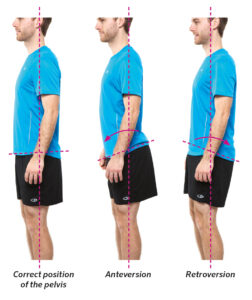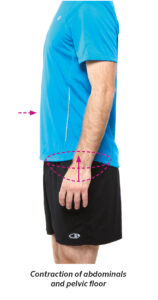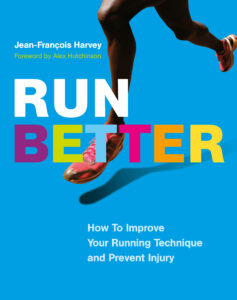
In this excerpt from his recently released book, Run Better: How to Improve Your Running Technique and Prevent Injury, Jean-François Harvey—athlete, kinesiologist, osteopath, teacher, and former coach—shares his advice on why and how to engage a strong core to run better.
Why a strong core is important
To provide a foundation for your every movement
Your core plays an essential role in maintaining good posture and proper running technique. It is the foundation of every action and movement you make. You literally can’t move a muscle without your core coming into play.
Anyone who strains their deep abdominal muscles (one of the parts of the core) will quickly realize they are unable to do anything normally. Walking, lifting things, playing tennis, laughing, sneezing, having sex, running—you name it, everything becomes an ordeal.
To provide greater stability
A strong core will stabilize your body in all planes of motion. Having more stability between the ribs— front to back as well as up and down—gives a runner greater control, freedom, and efficiency. This overall stability requires our muscles to act as a whole and move three-dimensionally. Say goodbye to two-dimensional thinking.
To increase arm and leg strength
Think of your core as the root of your arms and legs, and all of the muscles that are attached to them. To exert any significant force with your arms or legs, your core must be solid and stable. If your core is weak, your movements will be limited. Anyone who wants to run effectively, therefore, will need a properly functioning core.
To stabilize your pelvis
Engaging your core will position your pelvis correctly, facilitating freedom of movement in your legs and providing a solid foundation to support your spine and your entire upper body. Your pelvis is not perfectly neutral, since when your body is leaning forward slightly it’s quite natural for the pelvis to tilt forward a little. However, runners often tend to tilt their pelvis too far forward (anteversion) or, more rarely, too far backward (retroversion).

How to engage your core
Engage your core as you run
Athletes are often advised to relax when they run. This doesn’t mean they should relax every muscle though, and especially not their core muscles. The trick is to contract your muscles just enough. As a guide, bear in mind that when running, your abdominals and pelvic floor muscles should be contracted to about 25 percent of their capacity. The following exercise can help you do this.
Do exercises to strengthen your core
Sometimes these muscles can grow dormant and disengaged—even in people who do a ton of sit-ups every day. Targeting them with specific training can be a huge boost to your running, and to your everyday life.
With training, your core will become stronger and more resilient, even allowing you to engage your muscles at less than 25 percent so you can save even more energy.
How to engage your abdominals and pelvic floor properly
 Take a deep breath in, then as you exhale, contract your deep abdominal muscles as much as possible by pulling your belly button in toward your spine. Release as you inhale. The next time you exhale, contract those muscles with half the intensity (50 percent), then inhale and release. Finally, contract those muscles with half the intensity again (25 percent) as you exhale.
Take a deep breath in, then as you exhale, contract your deep abdominal muscles as much as possible by pulling your belly button in toward your spine. Release as you inhale. The next time you exhale, contract those muscles with half the intensity (50 percent), then inhale and release. Finally, contract those muscles with half the intensity again (25 percent) as you exhale.
This is the intensity with which you should be contracting your abdominals when you run. Now hold that contraction and breathe a little more deeply. This should allow your belly to inflate slightly. As you can see, it’s no longer quite as simple as just breathing into your belly, as some people advocate.
To engage your pelvic floor muscles, try to picture sucking the centre upward. In women, the centre of the pelvic floor is between the anus and the vagina, and in men, between the anus and the scrotum. Avoid contracting these muscles in the traditional way—as if you were trying to stop urinating—since doing this can weaken your sphincters over time. Instead, suck the centre of your pelvic floor upward as you exhale, then release it completely as you inhale. Repeat the same gradual process you did for your deep abdominals until you reach 25 percent intensity.
Now contract both your deep abdominals and your pelvic floor to 25 percent intensity. Congratulations, you’ve now engaged your core! When you run, this contraction should become second nature. Pay attention to this aspect once in a while to make sure you are still engaging your core, but try not to clench your whole body as you do so.
As well as engaging your core muscles, it’s useful to keep a strong connection between your pubic bone and your sternum. This will stop your pelvis from tilting too far forward.
With practice, you won’t even have to give this activation a second thought; your core will engage automatically. So don’t worry, you won’t spend your whole run thinking about your pelvic floor. You’ll find there are plenty of more interesting things to think about!
Anatomy of the core
The key muscles of your core are the deep abdominals, the pelvic floor, and the quadratus lumborum. These muscles work as a team and are essential for all runners. Here’s a brief rundown.
Deep abdominals
The muscles that make up the deep abdominals are, in decreasing order of depth:
1. Transverse abdominal muscle
Think of the transverse abdominal muscle (TVA) as a belt around your abdomen that is attached to your lumbar spine. The TVA helps to lengthen your spine and promote good posture. It also protects your lumbar vertebrae.
2. Internal oblique muscles (small obliques)
These muscles work in conjunction with the TVA and enable you to twist.
3. External oblique muscles (great obliques)
These are the muscles that drive any twisting motion, and they also work in synergy with the TVA. The deep abdominals work together for optimal operation in all planes of motion. They are assisted by the rectus abdominus muscle (see sidebar about six-packs).
Pelvic floor
As any female runner who has gone through pregnancy will know very well, the muscles in the pelvic floor act to close the lower part of the pelvis and control pelvic pressure. These are the muscles that support your organs—bladder, rectum, and uterus or prostate—when you run. That’s a pretty useful function, you have to admit. The pelvic floor muscles work as a team with the deep abdominals. Without an effective pelvic floor, the abdominals cannot function properly, yet these muscles are often overlooked.
Quadratus lumborum
The quadratus lumborum (QL) muscles connect your pelvis to your lumbar spine and lower ribs, providing lateral stability to your spine. With every step you take, the QL muscles contract on the side of the lifted leg to prevent your pelvis from lowering. Many runners sway their pelvis from side to side as they run. But running is not the same thing as walking the catwalk! When they are tight, these muscles can cause pain in the lower back on one side or the other.
You don’t need a six-pack to run well
Take a look at the front covers of running magazines—especially Runner’s World—in the last 20 years. On most of them, you’ll find a photo of a female runner showing off her midriff, or a bare-chested male runner. The first thing one might wonder is: do runners always run half-naked? And the second: do we need to have chiselled abs like all these runners to be able to run well? The answer to both of these questions is no.
Runners do need excellent deep abdominal muscles for stability and in order to generate decent strength when they run. But superficial abdominals—commonly known as a six-pack—are of little use. Runners don’t spend their time doing sit-up movements when they run. They need good obliques and transverse abdominal muscles, but slogging through sit-ups every day won’t do them any good. It is far more useful to work out at a deeper level and to improve posture than to insist on achieving that superficially “perfect” set of abs.
 Excerpted from Run Better: How To Improve Your Running Technique and Prevent Injury by Jean-François Harvey. Published March 2017 by Greystone Books. Reproduced and condensed with permission from the publisher.
Excerpted from Run Better: How To Improve Your Running Technique and Prevent Injury by Jean-François Harvey. Published March 2017 by Greystone Books. Reproduced and condensed with permission from the publisher.







